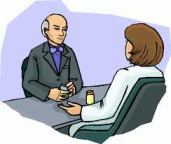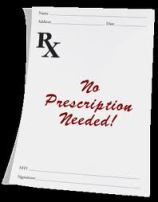I have a confession to make. I don’t think what I do each day makes any sense.
 Perhaps I should explain myself. Six months ago, I started my own private psychiatry practice (one of the reasons why I haven’t posted much to this blog, but I hope to pick up the pace again!). I made this decision after working for several years in various community clinics, county mental health systems, and three academic institutions. I figured that an independent practice would permit me to be a more effective psychiatrist, as I wouldn’t be encumbered by the restrictions and regulations of most of today’s practice settings.
Perhaps I should explain myself. Six months ago, I started my own private psychiatry practice (one of the reasons why I haven’t posted much to this blog, but I hope to pick up the pace again!). I made this decision after working for several years in various community clinics, county mental health systems, and three academic institutions. I figured that an independent practice would permit me to be a more effective psychiatrist, as I wouldn’t be encumbered by the restrictions and regulations of most of today’s practice settings.
My experience has strengthened my long-held belief that people are far more complicated than diagnoses or “chemical imbalances”—something I’ve written about on this blog and with which most psychiatrists would agree. But I’ve also made an observation that seems incompatible with one of the central dogmas of psychiatry. To put it bluntly, I’m not sure that psychiatric medications work.
Before you jump to the conclusion that I’m just another disgruntled, anti-medication psychiatrist who thinks we’ve all been bought and misled by the pharmaceutical industry, please wait. The issue here is, to me, a deeper one than saying that we drug people who request a pill for every ill. In fact, it might even be a stretch to say that medications never work. I’ve seen antidepressants, antipsychotics, mood stabilizers, and even interventions like ECT give results that are actually quite miraculous.
 But here’s my concern: For the vast majority of my patients, when a medication “works,” there are numerous other potential explanations, and a simple discussion may reveal multiple other hypotheses for the clinical response. And when you consider the fact that no two people “benefit” in quite the same way from the same drug, it becomes even harder to say what’s really going on. There’s nothing scientific about this process whatsoever.
But here’s my concern: For the vast majority of my patients, when a medication “works,” there are numerous other potential explanations, and a simple discussion may reveal multiple other hypotheses for the clinical response. And when you consider the fact that no two people “benefit” in quite the same way from the same drug, it becomes even harder to say what’s really going on. There’s nothing scientific about this process whatsoever.
And then, of course, there are the patients who just don’t respond at all. This happens so frequently I sometimes wonder whether I’m practicing psychiatry wrong, or whether my patients are playing a joke on me. But no, as far as I can tell, I’m doing things right: I prescribe appropriately, I use proper doses, and I wait long enough to see a response. My training is up-to-date; I’ve even been invited to lecture at national conferences about psychiatric meds. I can’t be that bad at psychiatry, can I?
Probably not. So if I assume that I’m not a complete nitwit, and that I’m using my tools correctly, I’m left to ask a question I never thought I’d ask: is psychopharmacology just one big charade? **
Maybe I feel this way because I’m not necessarily looking for medications to have an effect in the first place. I want my patients to get better, no matter what that entails. I believe that treatment is a process, one in which the patient (not just his or her chemistry) is central. When drugs “work,” several factors might explain why, and by the same token, when drugs don’t work, it might mean that something else needs to be treated instead—rather than simply switching to a different drug or changing the dose. Indeed, over the course of several sessions with a patient, many details inevitably emerge: persistent anxiety, secretive substance abuse, a history of trauma, an ongoing conflict with a spouse, or a medical illness. These often deserve just as much attention as the initial concern, if not more.
 Although our understanding of the pathophysiology of mental illness is pure conjecture, prescribing a medication (at least at present) is an acceptable intervention. What happens next is much more important. I believe that prescribers should continue to collect evidence and adjust their hypotheses accordingly. Unfortunately, most psychopharmacologists rarely take the time to discuss issues that can’t be explained by neurochemistry (even worse, they often try to explain all issues in terms of unproven neurochemistry), and dwindling appointment times mean that those who actually want to explore other causes don’t have the chance to do so.
Although our understanding of the pathophysiology of mental illness is pure conjecture, prescribing a medication (at least at present) is an acceptable intervention. What happens next is much more important. I believe that prescribers should continue to collect evidence and adjust their hypotheses accordingly. Unfortunately, most psychopharmacologists rarely take the time to discuss issues that can’t be explained by neurochemistry (even worse, they often try to explain all issues in terms of unproven neurochemistry), and dwindling appointment times mean that those who actually want to explore other causes don’t have the chance to do so.
So what’s a solution? This may sound extreme, but maybe psychiatry should reject the “biochemical model” until it’s truly “biochemical”—i.e., until we have ways of diagnosing, treating, and following illnesses as we do in most of the rest of medicine. In psychiatry, the use of medications and other “somatic” treatments is based on interview, gut feeling, and guesswork—not biology. That doesn’t mean we can’t treat people, but we shouldn’t profess to offer a biological solution when we don’t know the nature of the problem. We should admit our ignorance.
It would also help to allow (if not require) more time with psychiatric patients. This is important. If I only have 15-20 minutes with a patient, I don’t have time to ask about her persistent back pain, her intrusive brother-in-law, or her cocaine habit. Instead, I must restrict my questions to those that pertain to the drug(s) I prescribed at the last visit. This, of course, creates the perfect opportunity for confirmation bias—where I see what I expect to see.
 We should also make an effort to educate doctors and patients alike about how little we actually know. The subjects in trials to obtain FDA approval do NOT resemble real-world patients and are not evaluated or treated like real-world patients (and this is unlikely to change anytime soon because it works so well for the drug companies). Patients should know this. They should also know that the reliability of psychiatric diagnosis is poor in the first place, and that psychiatric illnesses have no established biochemical basis with which to guide treatment.
We should also make an effort to educate doctors and patients alike about how little we actually know. The subjects in trials to obtain FDA approval do NOT resemble real-world patients and are not evaluated or treated like real-world patients (and this is unlikely to change anytime soon because it works so well for the drug companies). Patients should know this. They should also know that the reliability of psychiatric diagnosis is poor in the first place, and that psychiatric illnesses have no established biochemical basis with which to guide treatment.
Finally, I should say that even though I call myself a psychiatrist and I prescribe drugs, I do not believe I’m taking advantage of my patients by doing so. All of my patients are suffering, and they deserve treatment. For some, drugs may play a key role in their care. But when I see my entire profession move towards a biochemical approach—without any good evidence for such a strategy, and without a fair assessment of alternative explanations for behavior—and see, in my own practice, how medications provide no real benefit (or, frequently, harm) compared with other treatments, I have to wonder whether we’ve gone WAY beyond what psychopharmacology can truly offer, and whether there’s any way to put some logic back into what we call psychiatric treatment.
** There are areas in which psychopharmacology is most definitely not a “charade.” These would include the uses of benzodiazepines, psychostimulants, and opioids like methadone and Suboxone. With each of these agents, the expected effect is quite predictable, and they can be very effective drugs for many people. Unfortunately, each of these can have an effect even in the absence of a diagnosis, and—probably not coincidentally—each has a potential for abuse.



 Posted by stevebMD
Posted by stevebMD 































